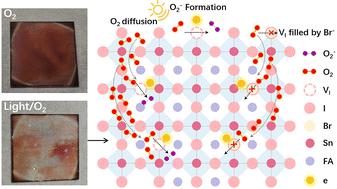当前位置:
X-MOL 学术
›
Energy Environ. Sci.
›
论文详情
Our official English website, www.x-mol.net, welcomes your
feedback! (Note: you will need to create a separate account there.)
Revealing superoxide-induced degradation in lead-free tin perovskite solar cells
Energy & Environmental Science ( IF 32.4 ) Pub Date : 2022-10-27 , DOI: 10.1039/d2ee02796h Zhihao Zhang 1 , Xuesong Tian 2 , Can Wang 3 , Jialun Jin 1 , Yiting Jiang 1 , Qin Zhou 3 , Jingwei Zhu 1 , Jianbin Xu 3 , Rui He 1 , Yuanfang Huang 1 , Shengqiang Ren 1 , Cong Chen 1 , Peng Gao 3 , Run Long 2 , Dewei Zhao 1
Energy & Environmental Science ( IF 32.4 ) Pub Date : 2022-10-27 , DOI: 10.1039/d2ee02796h Zhihao Zhang 1 , Xuesong Tian 2 , Can Wang 3 , Jialun Jin 1 , Yiting Jiang 1 , Qin Zhou 3 , Jingwei Zhu 1 , Jianbin Xu 3 , Rui He 1 , Yuanfang Huang 1 , Shengqiang Ren 1 , Cong Chen 1 , Peng Gao 3 , Run Long 2 , Dewei Zhao 1
Affiliation

|
The poor stability of lead (Pb)-free tin (Sn)-based perovskites under only oxygen (O2) exposure has attracted extensive research, while their stability under simultaneous light and O2 (light/O2) exposure is unexplored. Herein, we found that the (NH2)2CHSnI3 (FASnI3) perovskite degrades more severely when exposed to light/O2 than only O2, which we attribute to the superoxide generated via the reaction between O2 and photoexcited electrons. We propose the superoxide-induced degradation routes of FASnI3. Fluorescent molecular probe results indicate higher yield of superoxide in FASnI3 than in FAPbI3. Density functional theory simulation results rationalize that the formation energy of the most preferred sites (iodine vacancy, VI) for superoxide formation in FASnI3 is much lower than that in FAPbI3; meanwhile, superoxide formation at VI is more energetically favorable in FASnI3. A targeted strategy by incorporating halide-containing additives is applied to fill the VI in FASnI3 to suppress superoxide formation. Combined with superoxide yield measurement, capacitance-dominated characterization can systematically differentiate the reduction of surface and interior VI after modification. Understanding the degradation mechanism of FASnI3 upon light/O2 exposure manifests the fatal effect of superoxide on the stability of Sn-based perovskite solar cells.
中文翻译:

揭示无铅锡钙钛矿太阳能电池中超氧化物诱导的降解
仅在氧气 (O 2 ) 暴露下的无铅 (Pb) 锡 (Sn) 基钙钛矿的稳定性差已吸引了广泛的研究,而它们在同时光照和 O 2 (光/O 2 ) 暴露下的稳定性尚待探索。在此,我们发现(NH 2 ) 2 CHSnI 3 (FASnI 3 ) 钙钛矿在暴露于光/O 2时比仅O 2降解更严重,我们将其归因于通过O 2 和光激发电子之间的反应产生的超氧化物。我们提出了超氧化物诱导的 FASnI 3降解途径. 荧光分子探针结果表明FASnI 3 中的超氧化物产率高于FAPbI 3中的超氧化物产率。密度泛函理论模拟结果证明FASnI 3 中超氧化物形成的最优选位点(碘空位,VI )的形成能远低于FAPbI 3 中的形成能;同时,V I处的超氧化物形成在 FASnI 3中更有利。采用含卤添加剂的靶向策略填充FASnI 3中的 VI以抑制超氧化物的形成。结合超氧化物产率测量,以电容为主的表征可以系统地区分修饰后表面和内部 V I的减少。了解 FASnI 3在光/O 2暴露下的降解机制表明了超氧化物对 Sn 基钙钛矿太阳能电池稳定性的致命影响。
更新日期:2022-10-27
中文翻译:

揭示无铅锡钙钛矿太阳能电池中超氧化物诱导的降解
仅在氧气 (O 2 ) 暴露下的无铅 (Pb) 锡 (Sn) 基钙钛矿的稳定性差已吸引了广泛的研究,而它们在同时光照和 O 2 (光/O 2 ) 暴露下的稳定性尚待探索。在此,我们发现(NH 2 ) 2 CHSnI 3 (FASnI 3 ) 钙钛矿在暴露于光/O 2时比仅O 2降解更严重,我们将其归因于通过O 2 和光激发电子之间的反应产生的超氧化物。我们提出了超氧化物诱导的 FASnI 3降解途径. 荧光分子探针结果表明FASnI 3 中的超氧化物产率高于FAPbI 3中的超氧化物产率。密度泛函理论模拟结果证明FASnI 3 中超氧化物形成的最优选位点(碘空位,VI )的形成能远低于FAPbI 3 中的形成能;同时,V I处的超氧化物形成在 FASnI 3中更有利。采用含卤添加剂的靶向策略填充FASnI 3中的 VI以抑制超氧化物的形成。结合超氧化物产率测量,以电容为主的表征可以系统地区分修饰后表面和内部 V I的减少。了解 FASnI 3在光/O 2暴露下的降解机制表明了超氧化物对 Sn 基钙钛矿太阳能电池稳定性的致命影响。











































 京公网安备 11010802027423号
京公网安备 11010802027423号